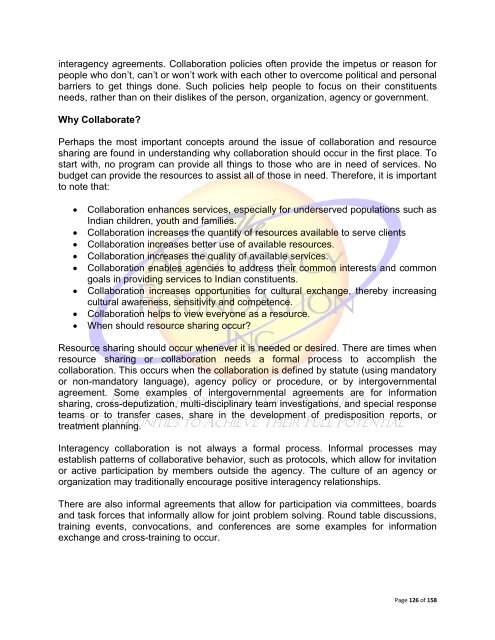Native American Youth In The Juvenile Justice System
Native American Youth In The Juvenile Justice System
Native American Youth In The Juvenile Justice System
You also want an ePaper? Increase the reach of your titles
YUMPU automatically turns print PDFs into web optimized ePapers that Google loves.
interagency agreements. Collaboration policies often provide the impetus or reason for<br />
people who don’t, can’t or won’t work with each other to overcome political and personal<br />
barriers to get things done. Such policies help people to focus on their constituents<br />
needs, rather than on their dislikes of the person, organization, agency or government.<br />
Why Collaborate?<br />
Perhaps the most important concepts around the issue of collaboration and resource<br />
sharing are found in understanding why collaboration should occur in the first place. To<br />
start with, no program can provide all things to those who are in need of services. No<br />
budget can provide the resources to assist all of those in need. <strong>The</strong>refore, it is important<br />
to note that:<br />
<br />
<br />
<br />
<br />
<br />
<br />
<br />
<br />
Collaboration enhances services, especially for underserved populations such as<br />
<strong>In</strong>dian children, youth and families.<br />
Collaboration increases the quantity of resources available to serve clients<br />
Collaboration increases better use of available resources.<br />
Collaboration increases the quality of available services.<br />
Collaboration enables agencies to address their common interests and common<br />
goals in providing services to <strong>In</strong>dian constituents.<br />
Collaboration increases opportunities for cultural exchange, thereby increasing<br />
cultural awareness, sensitivity and competence.<br />
Collaboration helps to view everyone as a resource.<br />
When should resource sharing occur?<br />
Resource sharing should occur whenever it is needed or desired. <strong>The</strong>re are times when<br />
resource sharing or collaboration needs a formal process to accomplish the<br />
collaboration. This occurs when the collaboration is defined by statute (using mandatory<br />
or non-mandatory language), agency policy or procedure, or by intergovernmental<br />
agreement. Some examples of intergovernmental agreements are for information<br />
sharing, cross-deputization, multi-disciplinary team investigations, and special response<br />
teams or to transfer cases, share in the development of predisposition reports, or<br />
treatment planning.<br />
<strong>In</strong>teragency collaboration is not always a formal process. <strong>In</strong>formal processes may<br />
establish patterns of collaborative behavior, such as protocols, which allow for invitation<br />
or active participation by members outside the agency. <strong>The</strong> culture of an agency or<br />
organization may traditionally encourage positive interagency relationships.<br />
<strong>The</strong>re are also informal agreements that allow for participation via committees, boards<br />
and task forces that informally allow for joint problem solving. Round table discussions,<br />
training events, convocations, and conferences are some examples for information<br />
exchange and cross-training to occur.<br />
Page 126 of 158

















